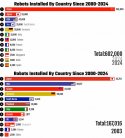You are using an out of date browser. It may not display this or other websites correctly.
You should upgrade or use an alternative browser.
You should upgrade or use an alternative browser.
Robotics and humanoid robotics & civilian drones discussion
- Thread starter tphuang
- Start date
Kuka is considered foreign in these stats, but I think in reality, it should be considered domestic, since it's all owned domestically at this pointare we considering Kuka chinese in this conversaiton?
@sunnymaxi do you have the article on ABB using Chinese supply chain?
Xinhua News Agency team visited ABB factory in December 2023.. and they interviewed, Tarak Mehta, president of ABB's Motion Business Area..Kuka is considered foreign in these stats, but I think in reality, it should be considered domestic, since it's all owned domestically at this point
@sunnymaxi do you have the article on ABB using Chinese supply chain?
"We have ramped up quite significantly the research and development (R&D) resources to ensure that China's needs are met with local industry and the local technical capacity. We are investing more in R&D and ensuring that our supply chains are locally self-sufficient in China," he said.
Noting that December marks the first anniversary of the opening of a 150 million-U.S.-dollar robotics mega-factory of the company in Shanghai, Mehta said that around 15,000 of its 100,000-plus workforce are now located in China..
FriedRiceNSpice
Captain
We have seen what happens when Chinese companies suprass foreign companies in both quality and price, they tend to dominate the chinese market so badly that foreign competitors are completely driven out and then proceed to dominate the global market so badly that foreign companies are completely driven out of business. We will know that chinese companies have suprassed Japanese ones when they start to take over the global market and when America starts to raise "security concerns" on "oversupply". We can also compare the specs on high end robot arms and find that Japanese companies are still largely on the top.
There are only 5 markets for industrial robots that matter: China, Germany, Japan, US, and SK. The Chinese market is larger than the rest combined so foreign expansion should not be a priority/benchmark at all. German and Japan are both have their own industrial robot producers and will favor their own products. US will move to block Chinese market access the moment Chinese robots start taking significant market share. So the only realistic market for expansion is SK, which is by far the smallest of the relevant markets. Goal should only be to supply the Chinese market with competitive and cost-effective products in order to further enhance competitiveness of Chinese manufacturing, as industrial robots should be viewed as an input / intermediate good. Foreign markets are irrelevant.
There are only 5 markets for industrial robots that matter: China, Germany, Japan, US, and SK. The Chinese market is larger than the rest combined so foreign expansion should not be a priority/benchmark at all. German and Japan are both have their own industrial robot producers and will favor their own products. US will move to block Chinese market access the moment Chinese robots start taking significant market share. So the only realistic market for expansion is SK, which is by far the smallest of the relevant markets. Goal should only be to supply the Chinese market with competitive and cost-effective products in order to further enhance competitiveness of Chinese manufacturing, as industrial robots should be viewed as an input / intermediate good. Foreign markets are irrelevant.
@tacoburger
I think there is another way of looking at it.
We can clearly see that Chinese-made industrial robots will be the lowest cost and highest performance for more robot categories as time goes on. Given the size of the Chinese market (larger than the rest of the world combined), we will see a virtuous cycle where more robot sales = more revenue = more R&D spending to develop better robots = more sales.
If German, Japanese and US companies don't use Chinese robots, their companies will have higher manufacturing costs.
So they will lose out on manufacturing to Chinese companies using Chinese robots.
Taken to its logical conclusion, if superior Chinese industrial robots are only available in China, that means overseas factories will tend to go bankrupt, and that factory activity end up in China.
So yes, foreign sales of Chinese robots should be an afterthought.
HikRobot hitting 100k in AMR production
Exceptionally good report on China's robotics scene. Some unknown data (at least to me) present as well.
Including some highlights (mostly of details that are new to me):
Including some highlights (mostly of details that are new to me):
- "From 2015 to 2022, China's annual production of industrial robots soared from 33,000 units to 443,000 units. The latest data from the National Bureau of Statistics shows that the production volume in the first quarter of this year reached 120,000 units." The production volume is still growing!
- "According to the International Federation of Robotics (IFR), in 2023, China's export volume of industrial robots reached a new high of 118,300 units, while the import volume was 82,400 units." Never knew these stats, so in essence China is a net exporter of industrial robots now, and the volumes are significant.
speaking of low altitude economy. In the 8th world drone conference, 500 companies brought 4000+ models to the event
AiHarmony system was unveiled for the first time
looks like Huawei will provide this system cooperating with Hisilicon and Harmony team along with drone research centers
The number of robots actually went down in TW

